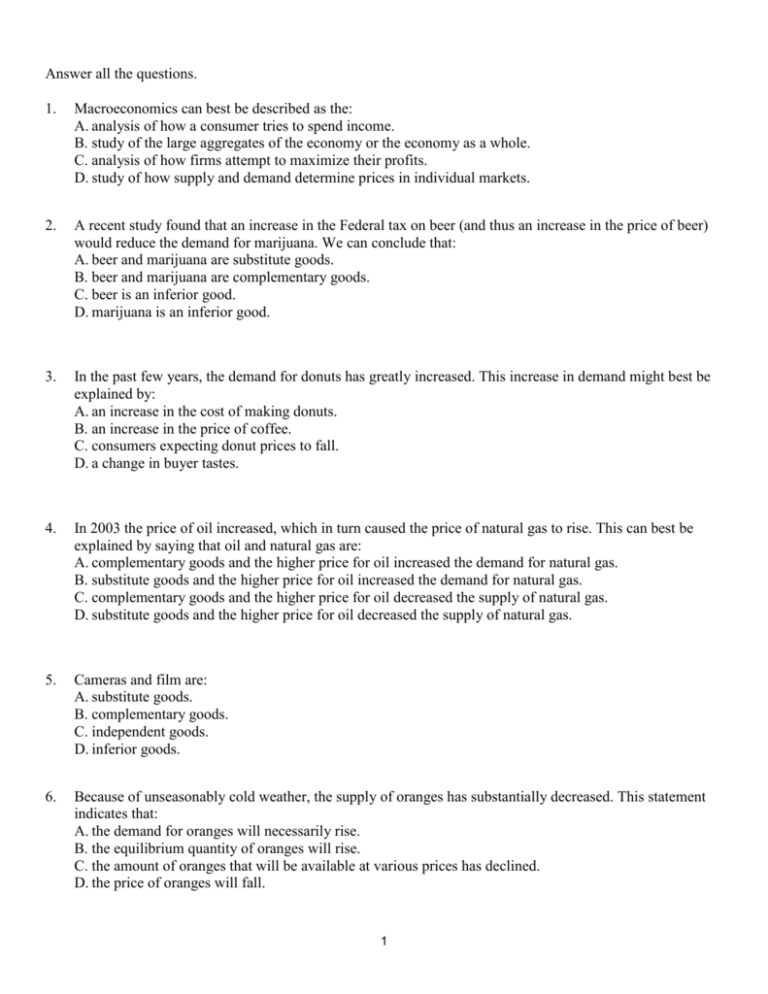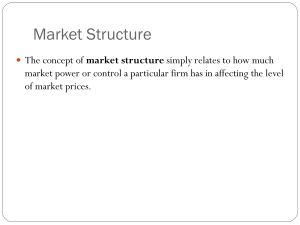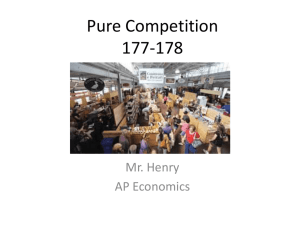Economics Exam Questions: Macro & Micro
advertisement

Answer all the questions. 1. Macroeconomics can best be described as the: A. analysis of how a consumer tries to spend income. B. study of the large aggregates of the economy or the economy as a whole. C. analysis of how firms attempt to maximize their profits. D. study of how supply and demand determine prices in individual markets. 2. A recent study found that an increase in the Federal tax on beer (and thus an increase in the price of beer) would reduce the demand for marijuana. We can conclude that: A. beer and marijuana are substitute goods. B. beer and marijuana are complementary goods. C. beer is an inferior good. D. marijuana is an inferior good. 3. In the past few years, the demand for donuts has greatly increased. This increase in demand might best be explained by: A. an increase in the cost of making donuts. B. an increase in the price of coffee. C. consumers expecting donut prices to fall. D. a change in buyer tastes. 4. In 2003 the price of oil increased, which in turn caused the price of natural gas to rise. This can best be explained by saying that oil and natural gas are: A. complementary goods and the higher price for oil increased the demand for natural gas. B. substitute goods and the higher price for oil increased the demand for natural gas. C. complementary goods and the higher price for oil decreased the supply of natural gas. D. substitute goods and the higher price for oil decreased the supply of natural gas. 5. Cameras and film are: A. substitute goods. B. complementary goods. C. independent goods. D. inferior goods. 6. Because of unseasonably cold weather, the supply of oranges has substantially decreased. This statement indicates that: A. the demand for oranges will necessarily rise. B. the equilibrium quantity of oranges will rise. C. the amount of oranges that will be available at various prices has declined. D. the price of oranges will fall. 1 7. Brenda says, "You would have to pay me $50 to attend that pro wrestling event." For Brenda, the marginal utility of the event is: A. zero. B. positive, but declines rapidly. C. negative. D. positive, but less than the ticket price. 8. The utility-maximizing rule: A. is inconsistent with the law of demand. B. implies a leftward shifting demand curve. C. implies a perfectly elastic demand curve. D. is consistent with the law of demand. 9. Which of the following represents a long-run adjustment? A. a farmer uses an extra dose of fertilizer on his corn crop B. unable to meet foreign competition, a U.S. watch manufacturer sells one of its branch plants C. a steel manufacturer cuts back on its purchases of coke and iron ore D. a supermarket hires four additional clerks 10. Which of the following is a short-run adjustment? A. A local bakery hires two additional bakers. B. Six new firms enter the plastics industry. C. The number of farms in the United States declines by 5 percent. D. BMW constructs a new assembly plant in South Carolina. 11. In the long run: A. all costs are variable costs. B. all costs are fixed costs. C. variable costs equal fixed costs. D. fixed costs are greater than variable costs. 12. Economists would describe the U.S. automobile industry as: A. purely competitive. B. an oligopoly. C. monopolistically competitive. D. a pure monopoly. 13. Which of the following industries most closely approximates pure competition? A. agriculture B. farm implements C. clothing D. steel 2 14. A purely competitive seller is: A. both a "price maker" and a "price taker." B. neither a "price maker" nor a "price taker." C. a "price taker." D. a "price maker." 15. The MR = MC rule applies: A. to firms in all types of industries. B. only to monopolies. C. only when the firm is a "price taker." D. only to purely competitive firms. 16. A firm finds that at its MR = MC output, its TC = $1000, TVC = $800, TFC = $200, and total revenue is $900. This firm should: A. shut down in the short run. B. produce because the resulting loss is less than its TFC. C. produce because it will realize an economic profit. D. liquidate its assets and go out of business. 17. The term allocative efficiency refers to: A. the level of output that coincides with the intersection of the MC and AVC curves. B. minimization of the AFC in the production of any good. C. the production of the product-mix most desired by consumers. D. the production of a good at the lowest average total cost. 18. The term productive efficiency refers to: A. any short-run equilibrium position of a competitive firm. B. the production of the product-mix most desired by consumers. C. the production of a good at the lowest average total cost. D. fulfilling the condition P = MC. 19. Which of the following approximates a pure monopoly? A. the foreign exchange market B. the Kansas City wheat market C. the diamond market D. the soft drink market 20. Which of the following is a characteristic of pure monopoly? A. close substitute products B. barriers to entry C. the absence of market power D. "price taking" 3 21. A pure monopolist's demand curve is: A. downsloping. B. upsloping. C. parallel to the vertical axis. D. parallel to the horizontal axis. 22. The MR = MC rule: A. applies only to pure competition. B. applies only to pure monopoly. C. does not apply to pure monopoly because price exceeds marginal revenue. D. applies both to pure monopoly and pure competition. 23. If a regulatory commission wants to provide a natural monopoly with a fair return, it should establish a price that is equal to: A. minimum average fixed cost. B. average total cost. C. marginal cost. D. marginal revenue. 24. Monopolistic competition is characterized by a: A. few dominant firms and low entry barriers. B. large number of firms and substantial entry barriers. C. large number of firms and low entry barriers. D. few dominant firms and substantial entry barriers. 25. A significant difference between a monopolistically competitive firm and a purely competitive firm is that the: A. former does not seek to maximize profits. B. latter recognizes that price must be reduced to sell more output. C. former sells similar, although not identical, products. D. former's demand curve is perfectly inelastic. 26. When a monopolistically competitive firm is in long-run equilibrium: A. production takes place where ATC is minimized. B. marginal revenue equals marginal cost and price equals average total cost. C. normal profit is zero and price equals marginal cost. D. economic profit is zero and price equals marginal cost. 27. The automobile, household appliance, and automobile tire industries are all illustrations of: A. homogeneous oligopoly. B. monopolistic competition. C. pure monopoly. D. differentiated oligopoly. 4 28. Use your basic knowledge and your understanding of market structures to answer this question. Which of the following companies most closely approximates a differentiated oligopolist in a highly concentrated industry? A. Subway Sandwiches B. Pittsburgh Plate Glass C. Ford Motor Company D. Kaiser Aluminum. 29. Which of the following is the best example of oligopoly? A. women's dress manufacturing B. automobile manufacturing C. restaurants D. cotton farming 30. As a general rule, oligopoly exists when the four-firm concentration ratio: A. exceeds the Herfindahl index. B. is less than the Herfindahl index. C. is 40 percent or more. D. is 15 percent or more. 5







